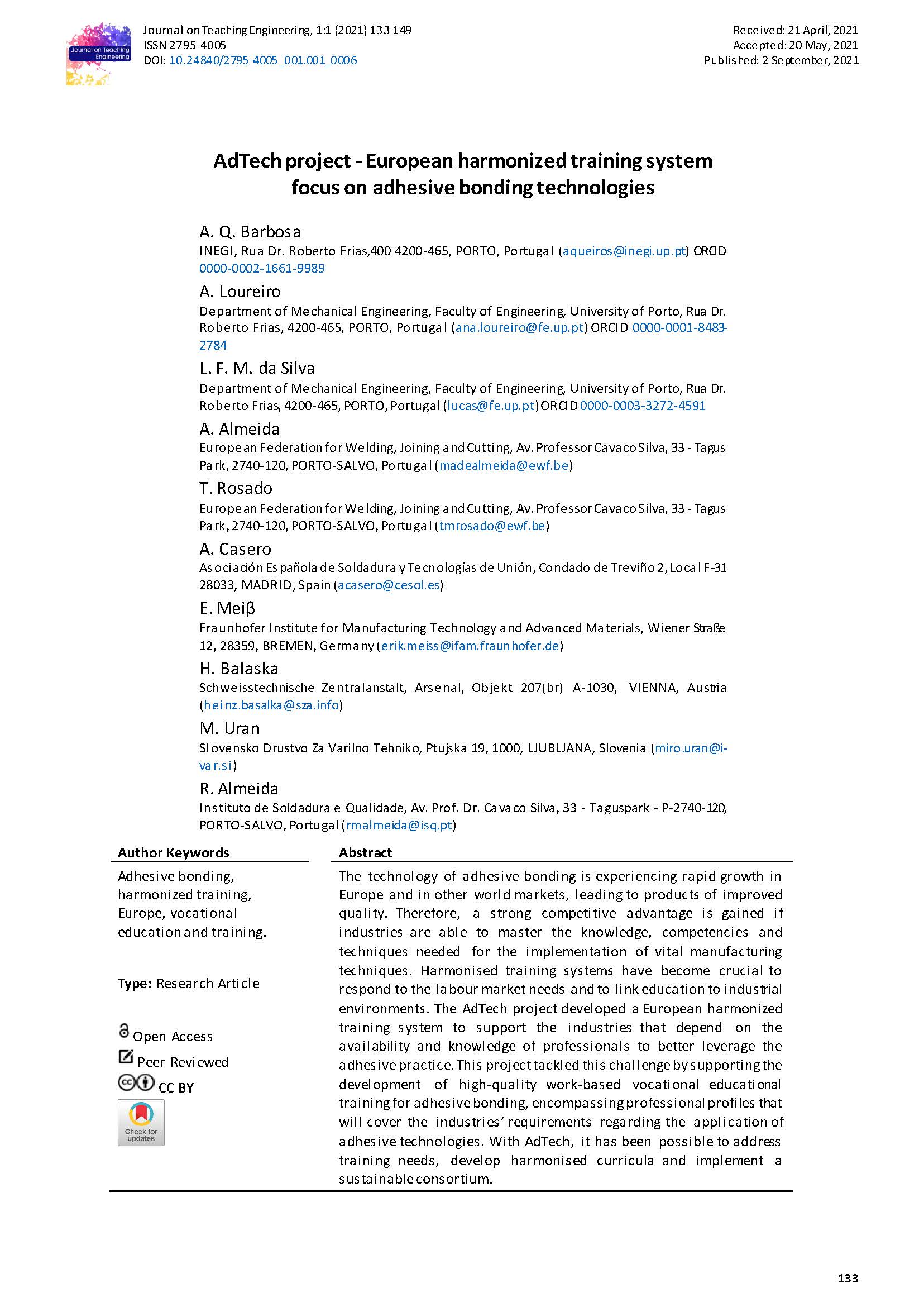AdTech project European harmonized training system focus on adhesive bonding technologies
Main Article Content
Abstract
The technology of adhesive bonding is experiencing rapid growth in Europe and in other world markets, leading to products of improved quality. Therefore, a strong competitive advantage is gained if industries are able to master the knowledge, competencies and techniques needed for the implementation of vital manufacturing techniques. Harmonised training systems have become crucial to respond to the labour market needs and to link education to industrial environments. The AdTech project developed a European harmonized training system to support the industries that depend on the availability and knowledge of professionals to better leverage the adhesive practice. This project tackled this challenge by supporting the development of high-quality work-based vocational educational training for adhesive bonding, encompassing professional profiles that will cover the industries’ requirements regarding the application of adhesive technologies. With AdTech, it has been possible to address training needs, develop harmonised curricula and implement a sustainable consortium.
Article Details

This work is licensed under a Creative Commons Attribution 4.0 International License.
References
AdTech. 2015. "Intellectual Output 6 - Operational ECVET kit–User Guide". https://www.fswtech.eu/documents.html.
AdTech. 2016. "Intellectual Output 2 - European Adhesive Bonder Profile Curricula". http://www.adtecheducation.com/result.html.
AdTech. 2017a. European Harmonized Training for Personnel working with Adhesive Bonding Technology - Final Report. Porto: Universidade do Porto.
AdTech. 2017b. "European Recommendation for Adhesive Bonding Professional". http://www.adtecheducation.com/result.html.
AdTech. 2018. Project Dissemination and Exploitation Report. Porto: Universidade do Porto.
Almeida, A., T. Rosado, A. Casero, E. Meiβ, H. Balaska, A. Loureiro, L. F. M. da Silva, M. Uran, and R. Almeida. 2018. "European Harmonised Training for Adhesive Bonding Technology | AdTech project". Paper presented at MDA2018 - 2nd International Conference on Materials Design and Applications, Porto, Portugal, July 2018.
Banea, M. D., and L. F. M. da Silva. 2016. "Adhesively bonded joints in composite materials: An overview". Proceedings of the Institution of Mechanical Engineers, Part L: Journal of Materials: Design and Applications 223, no. 1: 1-18. https://doi.org/10.1243/14644207jmda219.
Banea, M. D., L. F. M. da Silva, R. D. S. G. Campilho, and C. Sato. 2014. "Smart adhesive joints: An overview of recent developments". The Journal of Adhesion 90, no. 1: 16-40. https://doi.org/10.1080/00218464.2013.785916.
BSI (British Standards Institution). 2016. Adhesives. Terms and definitions. BS EN 923:2015. UK: British Standards Institution.
Cognard, P., ed. 2006. Adhesives and sealants: General knowledge, application of adhesives, new curing techniques. Elsevier.
Costa, M. B. S. F. P. da. 2013. "Development of a web application for the design of adhesive joints". Master’s thesis, Faculty of Engineering, University of Porto. https://hdl.handle.net/10216/67629.
da Silva, L. F. M., D. A. Dillard, B. Blackman, and R. D. Adams, eds. 2012. Testing adhesive joints: Best practices. Wiley-VCH. https://doi.org/10.1002/9783527647026.
da Silva, L. F. M., R. F. T. Lima, and R. M. S. Teixeira. 2009. "Development of a computer program for the design of adhesive joints". The Journal of Adhesion 85, no. 12: 889-918. https://doi.org/10.1080/00218460903307761.
da Silva, L. F. M., and A. Öchsner, eds. 2008. Modeling of adhesively bonded joints. Springer Berlin Heidelberg. https://doi.org/10.1007/978-3-540-79056-3.
da Silva, L. F. M., A. Öchsner, and R. D. Adams, eds. 2018. Handbook of adhesion technology. 2nd ed. Springer International Publishing. https://doi.org/10.1007/978-3-319-55411-2.
da Silva, L. F. M., A. Pirondi, and A. Öchsner, eds. 2011. Hybrid adhesive joints. Springer-Verlag Berlin Heidelberg. https://doi.org/10.1007/978-3-642-16623-5.
DIN (Deutsches Institut für Normung). 2015a. Adhesive bonding of railway vehicles and parts - Part 2: Qualification of manufacturer of adhesive bonded materials. DIN 6701-2. Berlin: DIN.
DIN (Deutsches Institut für Normung). 2015b. A-Z – Guideline of the Working Group Adhesive Bonding DIN 6701. Berlin: DIN.
DIN (Deutsches Institut für Normung). 2016. Adhesive bonding technology - Quality requirements for adhesive bonding processes - Part 1: Adhesive bonding process chain. DIN 2304. Berlin: DIN.
European Federation for Welding, Joining and Cutting. 2010a. EWF Guideline for European Adhesive Bonder - Minimum requirements for the education, examination and qualification. EWF-515r1-10/SV-02. EWF.
European Federation for Welding, Joining and Cutting. 2010b. EWF Guideline for European Adhesive Engineer - Minimum requirements for the education, examination and qualification. EWF-517r1-10. EWF.
European Federation for Welding, Joining and Cutting. 2010c. EWF Guideline for European Adhesive Specialist - Minimum requirements for the education, examination and qualification. EWF-516r1-10. EWF.
European Federation for Welding, Joining and Cutting. 2015. "AdTech - European Harmonized Training for Adhesive Bonding Technology". http://www.adtecheducation.com/result.html.
European Federation for Welding, Joining and Cutting. 2019. EWF Guideline for European Adhesive Bonder - Minimum requirements for the education, examination and qualification. EWF-515r2-19. EWF.
FEICA. 2018. "Markets - Value of the adhesive and sealant industry in Europe". https://www.feica.eu/our-industry/markets.
Loureiro, A. L., L. F. M. da Silva, and V. Migueis. 2016. Intellectual Output 1 – Report. Porto: Universidade do Porto.
Machado, J. J. M., P. M. R. Gamarra, E. A. S. Marques, and L. F. M. da Silva. 2018. "Improvement in impact strength of composite joints for the automotive industry". Composites Part B: Engineering 138: 243-55. https://doi.org/10.1016/j.compositesb.2017.11.038.
Marques, E. A. S., and L. F. M. da Silva. 2008. "Joint strength optimization of adhesively bonded patches". The Journal of Adhesion 84, no. 11: 915-34. https://doi.org/10.1080/00218460802505275.
Marques, E. A. S., L. F. M. da Silva, M. D. Banea, and R. J. C. Carbas. 2015. "Adhesive joints for low- and high-temperature use: An overview". The Journal of Adhesion 91, no. 7: 556-85. https://doi.org/10.1080/00218464.2014.943395.
Meiß, E. 2016. "DIN 2304: Quality requirements for adhesive bonding processes". Biuletyn Instytutu Spawalnictwa 60, no. 5: 20-23. https://doi.org/10.17729/ebis.2016.5/2.
Quintino, L., I. Fernandes, and E. Assunção. 2013. "European harmonised system for training and qualification of adhesive bonding personnel". Applied Adhesion Science 1, no. 1: Article number 2. https://doi.org/10.1186/2196-4351-1-2.
Wacker, G., D. Brügge, K. Fach, and W. Franzelius. 2004. "Theory and practice: Requirements for adhesive bonding in marine structures". Proceedings of the Institution of Mechanical Engineers, Part M: Journal of Engineering for the Maritime Environment 218, no. 4: 217-26. https://doi.org/10.1243/1475090043689356.
Wiesbaden, V. V. 2014. "Adhesive bonding - The joining technology of the 21st century". adhesion ADHESIVES&SEALANTS 11, no. 4: 16-18. https://doi.org/10.1365/s35784-014-0320-8.

